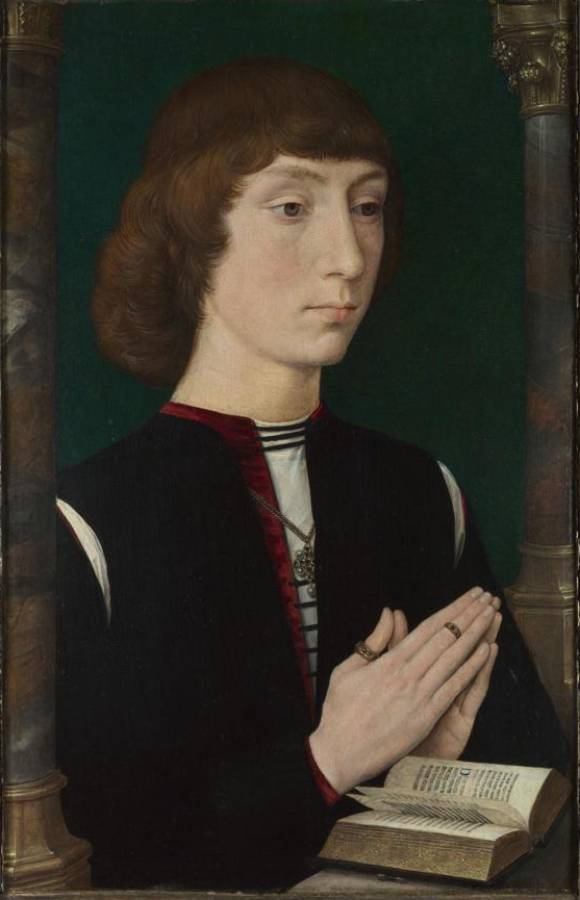Memling, Hans (c.1430-1494)
A Young Man at Prayer
c.1475
Oil on oak, 39 x 25.4 cm
National Gallery, London
A pale young man, hands folded in prayer, is engaged in private devotions. The book is presumably a prayer book or a Book of Hours. It has gilded edges and a golden clasp, and the text written in black ink with red rubrics (instructions) and blue initials. The portrait was clearly the left wing of a diptych or triptych. The right hand panel(s) would have displayed a religioius image, probably the Virgin Mary and Christ Child.
There is nothing to tell us who the sitter was, though he was evidently wealthy. He wears a red velvet doublet with a black robe over it, the right sleeve of which is folded over above his wrist to reveal a dark grey lining with a damask-like pattern. Both gown and doublet are slashed at the shoulder, allowing white puffs of the shirt to escape. A cross set with sapphires and surrounded by pearls hangs from the gold chain around his neck. His dress and haircut suggest a date of around 1475.
The two coloured marble columns have golden capitals and bases. Although they don’t relate convincingly to the figure or the surface on which his book rests, they suggest a luxurious setting. They are comparable to those in Memling’s Saint John the Baptist and Saint Lawrence, of before or around 1480. In those, however, the spatial relationships between the young man and his setting are more carefully considered, which could indicate that this painting is rather earlier. It may be dated to the mid-1470s.
Technical analysis shows us that there was underdrawing for the face and neck, probably indicating roughly where the head was to be. The lines in the hands and book are more confusing but probably record various ideas for the placing of the hands, which were narrower at one stage, and for the surface on which the book rests and the book itself, which may once have been larger. The underdrawing resembles that in other portraits by Hans Memling. The final positions of the face, hands and book were all fixed before the artist began to paint; few changes were made at the painting stage. The delicacy of detail and the skill of handling, particularly noticeable in the wet-in-wet passages, is typical of Memling.
Although the figure is in very good condition, the background has been damaged and overpainted. The frame, which is apparently original, has lost its original ground and decoration; the gilded strips are modern. It is not clear what its original decoration would have been. Both the mouldings and the structure of this frame are unusual but have some technical features in common with frames manufactured in Bruges around 1480. (NG)
